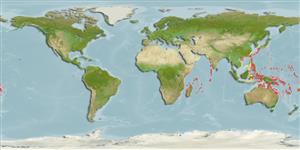Actinopterygii (ray-finned fishes) >
Anguilliformes (Eels and morays) >
Muraenidae (Moray eels) > Muraeninae
Etymology: Gymnothorax: Greek, gymnos = naked + Greek, thorax, -akos = breast (Ref. 45335).
Environment / Climate / Range
Ecology
Marine; reef-associated; depth range 0 - 20 m (Ref. 86942). Tropical, preferred ?
Indo-West Pacific: Oman and India east to Philippines; north to Japan, south to Australia.
Size / Weight / Age
Maturity: Lm ? range ? - ? cm
Max length : 80.0 cm TL male/unsexed; (Ref. 2334)
Dorsal
spines
(total): 0;
Dorsal
soft rays
(total): 0;
Anal
spines: 0;
Anal
soft rays: 0;
Vertebrae: 127 - 135. Color pale yellowish; dark brown spots clustering to form larger ones in about 4 irregular rows along the body. Margin of fins white in juveniles; reduced to tip of tail in adults. Vertebrae 127-135.
Not common. Found in shallow reefs, including tidepools (Ref 90102).
Life cycle and mating behavior
Maturity | Reproduction | Spawning | Eggs | Fecundity | Larvae
Chen, H.-M., K.-T. Shao and C.T. Chen, 1994. A review of the muraenid eels (Family Muraenidae) from Taiwan with descriptions of twelve new records. Zool. Stud. 33(1):44-64. (Ref. 6934)
IUCN Red List Status (Ref. 115185)
CITES (Ref. 94142)
Not Evaluated
Threat to humans
Harmless
Human uses
Fisheries: of no interest
More information
Common namesSynonymsMetabolismPredatorsEcotoxicologyReproductionMaturitySpawningFecundityEggsEgg development
ReferencesAquacultureAquaculture profileStrainsGeneticsAllele frequenciesHeritabilityDiseasesProcessingMass conversion
Tools
Special reports
Download XML
Internet sources
